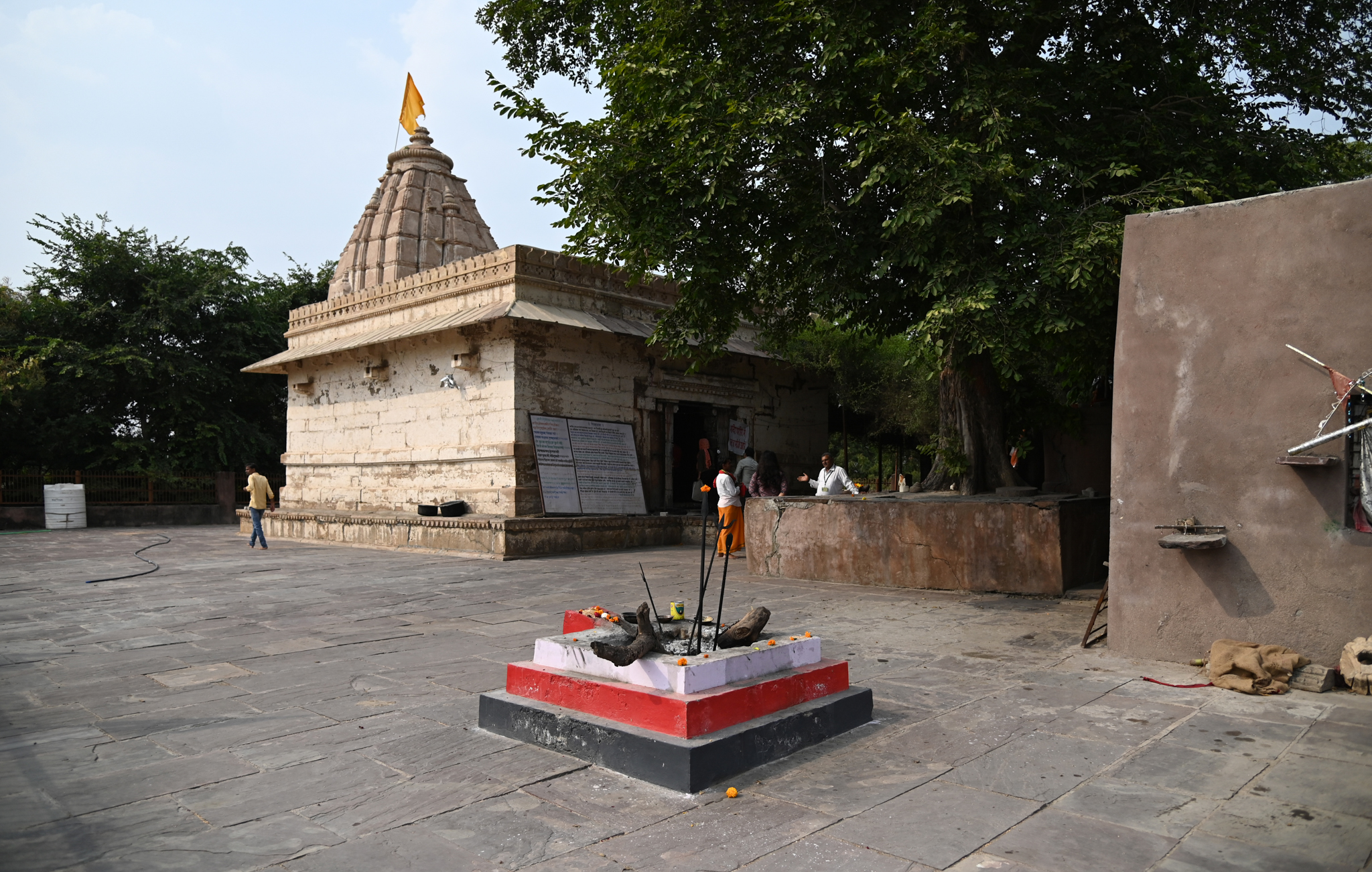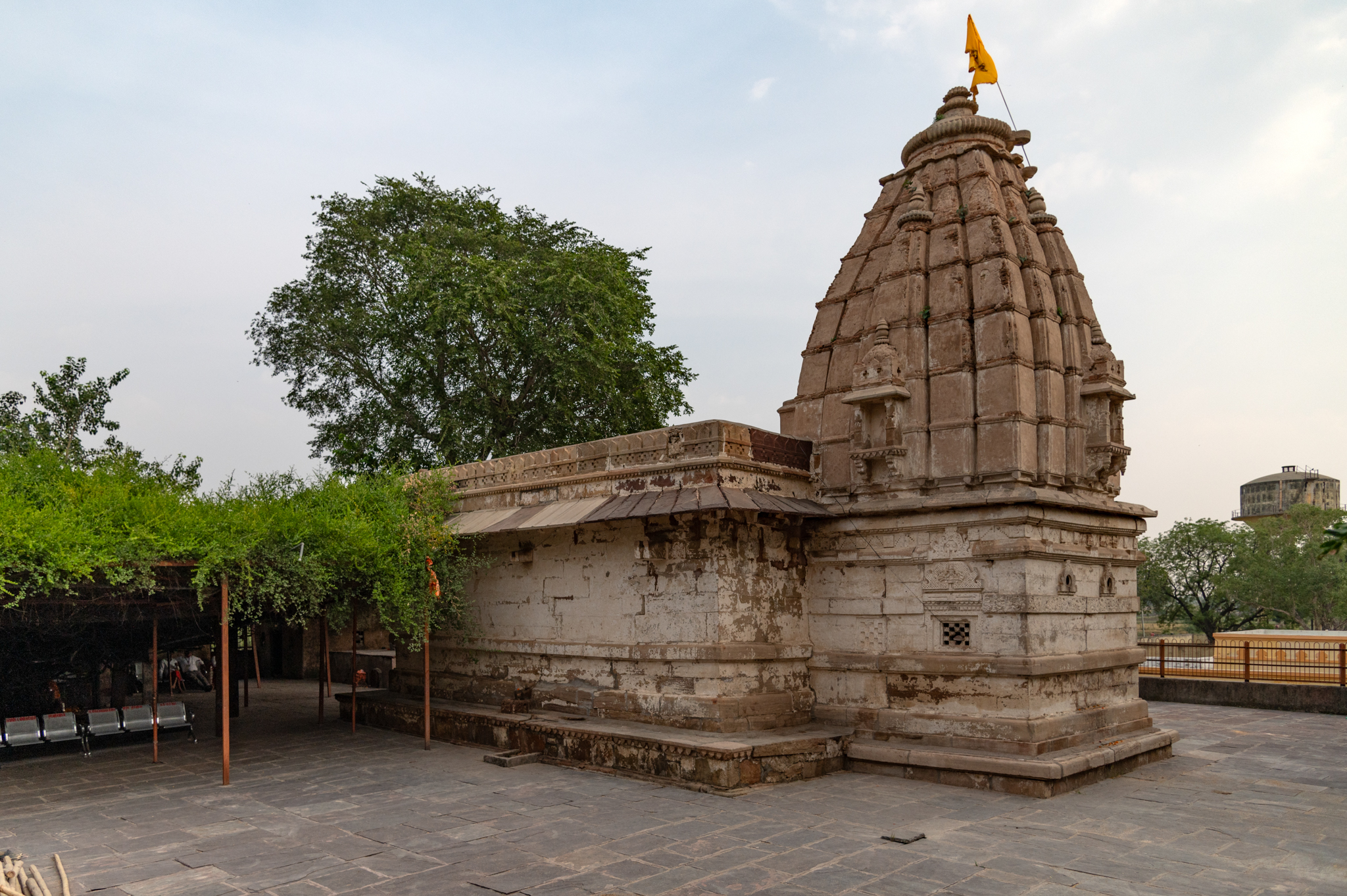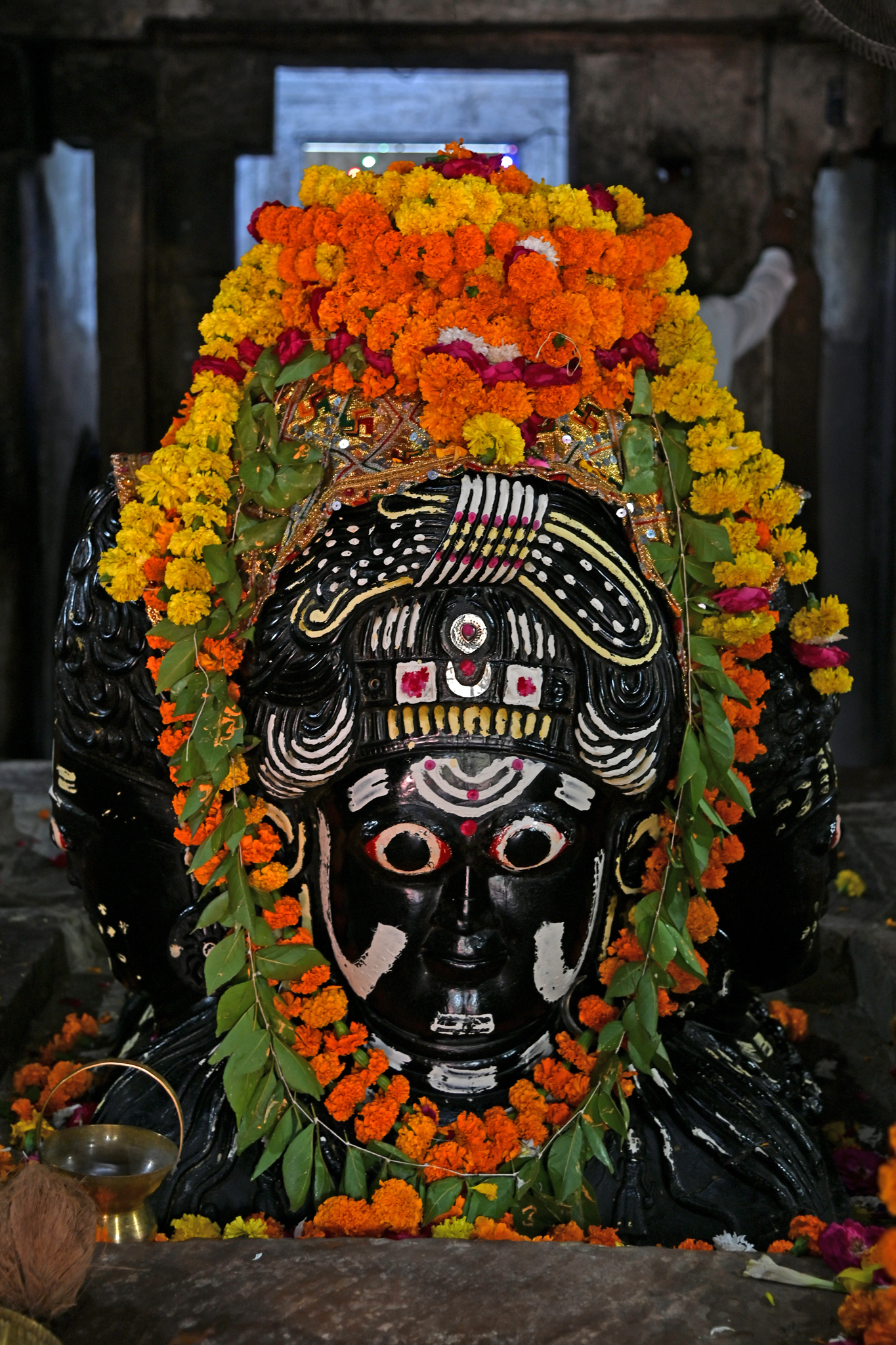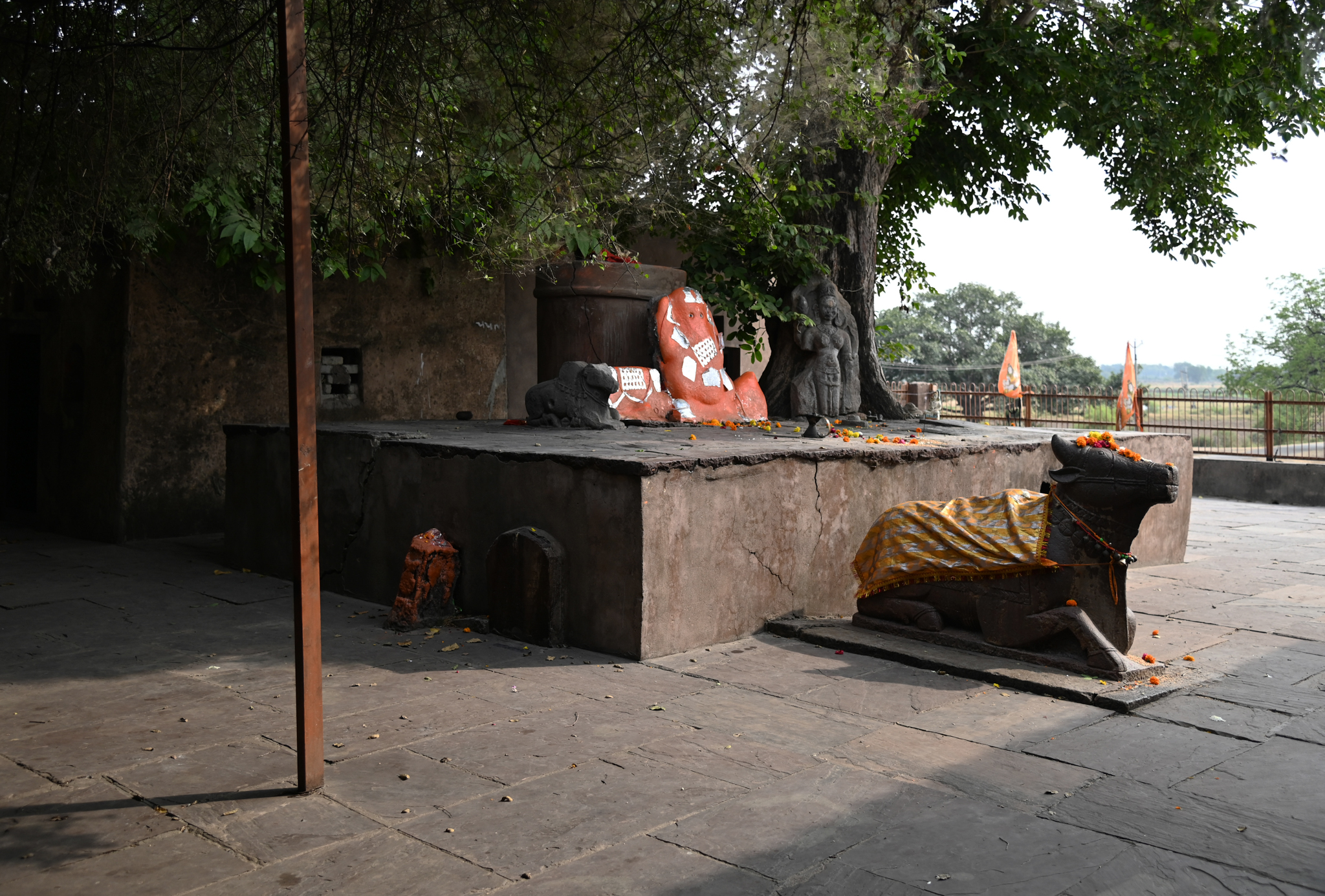Shiva Temple at Charchoma: What remains of a Gupta period temple
The Charchoma Shiva Temple (Image 1) is located in the village of Charchoma Maliya in the Kota district of Rajasthan. The temple is a National Protected Monument that falls under the jurisdiction of the Jaipur Circle of the Archaeological Survey of India (ASI). The temple's oldest surviving features trace their historical origins back to the late Gupta period, around the 7th century CE, and showcase regional variations of the Gupta style. The temple, which was renovated in the 19th century, now has a straightforward appearance with minimal decoration. Nonetheless, some parts of the temple retain original artwork, reflecting the aesthetics of the Gupta period. Notably, the Charchoma Shiva Temple has two significant inscriptions in late Gupta Brahmi letters, confirming its foundation around the time.

A set of stairs leads to the elevated area where the temple is located. Stone platforms or benches on three different levels flank the pathway leading to the platform, offering devotees a place to sit. Two other raised areas or stone platforms, close to the mulaprasada (main temple), house sculptures of deities and engraved stone steles. A smaller stone platform, to the northeast of the main temple, features a vermilion-covered deity under a tree. In front of the main temple, a larger platform encircles a tree and features sculptures of Ganesh (covered in vermilion), a goddess, and a Nandi (Image 2). A larger Nandi figure stands directly in front of the temple.
The main Shiva Temple is located at the center of the elevated top, facing east. Its plan includes a mandapa (pillared hall), antarala (vestibule), and a garbhagriha (sanctum sanctorum) (Image 3). The vertical elevation of the temple shows base mouldings, jangha (wall proper), and shikhara (superstructure).

The temple's garbhagriha is a small, simple, and plain structure from the inside. The only decoration visible is at the entrance of this space: the T-shaped doorframe (Image 4), which has multiple decorated shakhas (vertical mouldings on the door jamb). The bottom of the shakha depicts the rivers Goddess Ganga and Yamuna, which are presently in a bad state of preservation. On the right side, we see the river goddess standing, one hand resting on her waist and the other, seemingly withered, raised upward. Her uplifted hand may have been there to carry a water pot. She wears an elaborate headdress and adorns herself with beautiful necklaces, circular earrings, and bangles. Her lower garment is translucent, and she carries a scarf around her arms. Damage completely covers her lower body beneath her knees and along her chin. A dwarf attendant stands by her side, clutching a parasol above her head. The motif of depicting river goddesses emerged from the Gupta period onwards. This goddess's depiction bears resemblance to the terracotta river goddess of Ahichhatra, currently housed in the National Museum.
The carvings above the river Goddess depict a makara, facing upward, and four shakhas. The shakhas on the inner sides depict a seated dwarf figure holding a creeper emerging from his navel (Image 4). The undulating creeper is beautifully moving upward, enhancing the aesthetic appeal of this shakha. Different floral patterns adorn the next shaka, while leaf motifs adorn the third. Rosettes adorn the fourth shakha.

The last shakha, positioned at the extreme end, depicts an elaborate kirtimukha (face of glory). A dvarapala (attendant) stands above the kirtimukha, his weapon in hand (Image 4). He rests one hand on his waist and holds a spear in the other. He has heavy, open jatas (twisted locks of hair) and is shown wearing a lower garment with a robe draped around his arms. Dwarf figures decorate the shakha above the dvarapala, dancing and playing musical instruments such as the flute, bean, and drum. The stout dwarf figures, adorned with beautiful and thick curly hair, don a dhoti and hold a scarf around their arms.
The door's lalatabimba (lintel) features a carved mukhalinga (linga with a face), its head perched on a pedestal (Image 4). The face has arched eyebrows, two beautiful eyes, a broad nose, and defined lips. A third eye is on the forehead, and one can notice the heavy jatas. Flanking the linga, two devotees sit with folded hands, a gesture demonstrating respect and homage. Adjacent to these devotees, subtle depictions of maladharas (garland bearers) hold garlands for the deity.
Above the lalatabimba, several decorative mouldings adorn the structure. A floral motif decorates the first moulding above the lalatabimba. Upon closer inspection, the second moulding above the lalatabimba reveals numerous kirtimukhas carved in a manner similar to dentils. Additional mouldings sit above it, with two chaitya arches carved one above the other at the centre of these mouldings.
The temple's doorframe reflects the exquisite Gupta period characteristics. Its T-shape of the doorframe, presence of river goddesses, dvarapalas, elaborate kirtimukhas, and the intricate decoration of shakhas with various floral motifs and figures mirror architectural elements found in other famous Gupta temples of Madhya Pradesh and surrounding regions. Examples include the Parvati Temple at Nachna Kuthara, the Shiva Temple at Bhumara, and even the Dashavtar Temple at Deograh. A mukhalinga on the lalatabimba signifies the temple's dedication to Shiva. Despite the beautifully adorned doorframe of Charchoma Shiva Temple, its damage and fading in many areas hinder the visibility of its intricate features.
The garbhagriha, or inner sanctum, of the temple is a small and dimly lit chamber. It is noteworthy that while the temple is revered as a Shiva temple featuring a mukhalinga on the lalatabimba, the current deity housed in the garbhagriha is a sculpture of the Goddess Adi Shakti (Image 4). People actively worship the goddess sculpture and adorn it with clothing, masking her attributes. However, a prominent metal trident stands near the sculpture.
What stands out is that the sculpture of Adi Shakti is positioned at the center of a projection within the garbhagriha, which depicts male figures standing and holding a creeper's stem emerging from their navels. Above the goddess’s head, one can observe similar decoration of dentils and chaitya arches as seen in the doorframe of the garbhagriha.
Outside the garbhagriha lies an antarala, connecting it to the mandapa. The rectangular plain passage, or antechamber, has four pillars and two pilasters. The pillars have a square bottom and a circular upper shaft. The only visible decorative motif on the pillars is the carving of half lotuses on all four sides of the shaft. Bands of leaves and various floral motifs decorate the pilasters. Similar to the pillars, the central and upper portions of the pilasters feature full-blown lotuses for decoration.
Outside the garbhagriha lies an antarala, connecting it to the mandapa. The rectangular plain passage, or antechamber, has four pillars and two pilasters. The pillars have a square bottom and a circular upper shaft. The only visible decorative motif on the pillars is the carving of half lotuses on all four sides of the shaft. Bands of leaves and various floral motifs decorate the pilasters. Similar to the pillars, the central and upper portions of the pilasters feature full-blown lotuses for decoration.

The temple's mandapa (Image 6) is a rectangular hall accessible through a T-shaped entrance. Beautiful floral designs and undulating creepers, now wither-worn and visible only upon close observation, carve the doorframe of the entrance. Lotus medallions and animal figures decorate the udumbara (threshold), while dentils resembling wooden architecture adorn the uttaranga.

At the entrance, flanking the doorframe, stand two pillars, one on each side. These pillars are carved, with a square base that transitions into a hexagon, followed by a circular shaft adorned with a cushion-like design that serves as the base for brackets. There is an inscription outside the mandapa that discusses a pushpa vatika (groove or garden) where various trees, creepers, and flowers bloom. Among the trees mentioned are the Vakul tree, Priyangu creeper, Jalnaga, or the Varuna tree, Katuka, Hingu, and Dhoopal. [2]
A huge Chaturmukha linga (Image 6) sits on a stone platform inside the mandapa. Four pillars are positioned at the platform's four corners. These pillars are square at the base, transitioning into a hexagonal shape in the middle, and becoming circular at the top. Brackets atop the pillars support the mandapa ceiling, adhering to the trabeated system.
As suggested by the term chaturmukha, the linga has four faces, each facing one of the four cardinal directions. It is black in colour. According to popular lore, the Chaturmukha linga represents Shiva, Parvati, Brahma, and Vishnu (Image 7). Shiva's face facing east (entrance gate) is adorned with a heavy jatabhara (braided hairdo) atop his head. The linga's south face has a heavy jatamukuta (matted crown) on its head, as well as hairlocks cascading down to the shoulders. The west face (rear) also has a jatamukuta, albeit carved slightly differently from the other three. The north face has snail-shaped curls, culminating in a jatamukuta. A beautiful necklace adorns the deity. The Chaturmukha linga's four faces each have unique sringara (attributes).

Contrary to the interior of the temple, the exterior is characterised by simplicity and plainness, with only a few decorative elements. The garbhagriha is a small square structure that stands on plain base mouldings. A moulding divides the jangha into two registers (Image 3). The lower register is entirely plain, while the upper register features a broad floral band running across the walls. Checkered windows adorn the walls on the north and south sides, crowned by double chaitya arches. Two Chaitya arches, positioned next to each other, just above the floral band, serve as decorative elements on the rear wall, which lacks windows.
The double chaitya arch on the southern side features a depiction of Kartikeya in the lower arch (Image 8). Upon close examination, the sculpture reveals the attributes of the deity, depicted seated on a peacock and wielding a spear. The vahana (vehicle) and weapon unmistakably identify the figure as Kartikeya, the son of Shiva, to whom the temple was originally dedicated. The depiction of Kartikeya in the arch exhibits a style typical of the Gupta period. This frontal representation of the God of War with his attributes was Kartikeya's standard iconography during the Gupta period. Notably, Kartikeya's depictions not only graced the sculptural art of that era, but also graced the gold coins of Kumar Gupta.
The north wall of the garbhagriha depicts a bust of a deity in the lower Chaitya arch. This bust looks similar to the one found on the lalatabimba of the garbhagriha doorjamb. It is placed on a pedestal, which could be a yonipatta (the base slab of a Linga is designed as a womb or yoni), suggesting that the bust might be a mukhalinga (Image 9). However, due to the thick plaster and colour coating, the details of the bust are not clear, although it appears that the deity has a jatabhara on his head. Additionally, two flying celestial beings are shown on each side of the mukhalinga. The upper Chaitya arches on both sides show kirtimukha peering out of the arches, with another kirtimukha at the apex.
Above the jangha, a varandika (moulded parapet) is put up. This is a raised set of mouldings that separates the wall from the superstructure. It has four different types of mouldings: a kapotapalika (cyma eve cornice), an antarapatta (recessed face between projecting mouldings), and another moulding. The anatarapatta has projected square panels carved with the four-petalled flowers. The space in between depicts a triangular space filled with floral designs. A plain latina shikhara, a North Indian mono-spired superstructure with curvilinear vertical bands, rests on these mouldings. The shikhara is devoid of any ornamentation and figures, but one can notice the presence of niches topped by an udgama pediment on all three sides. At the apex, an amalaka (crowning member of the latina shikhara) is placed topped by a bijapuraka (fruit of citron).
The mandapa is a flat-roofed structure with a plain, simple base, adorned only with a single decorative band at the top. The walls are also plain but have an extended chhajja (eave) supported by brackets, which is the only decoration. At the upper section of the wall, projected spouts are installed at intervals to let air and light inside the mandapa.
The mandapa is a flat-roofed structure with a plain, simple base, embellished only with a single decorative band at the top. The walls are also plain, but an extended chhajja (eave) supported by brackets is the only decoration. The upper section of the wall installs projected spouts at intervals to allow air and light into the mandapa.
A water tank with a tall platform at its center is located outside the temple. This structure has chhattris on four corners, adding to the tank's beauty. These chhatris, made of sandstone, consist of a square platform and four pillars, topped with chhajja (eves) and a dome. The chhatris' domical roof suggests that they may be a later addition.
The Charchoma Shiva Temple is an important site for understanding the regional variation of the late Gupta style. Over time, the temple underwent modifications, resulting in the present structure of the temple site. These modifications serve as pieces of evidence of the temple’s enduring relevance since its foundation in the late Gupta period. Despite being an ASI protected site today, the Shiva Temple maintains its reverence and attracts numerous worshippers from the surrounding regions. It is also believed that the village of Charchoma derived its name from the Chaturmukha linga housed within the temple.
Footnotes:
[1] Mishra, Inscriptions of Rajasthan, vol. IV, 14.
[2] Mishra, Inscriptions of Rajasthan, vol. II, 13.
Bibliography
Archaeological Survey of India, Jaipur Circle. Charchoma Siva Temple. Archaeological Survey of India. n.d. https://asijaipurcircle.nic.in/Charchoma%20-%20Siva%20temple%20&%202%20unpublished%20Gupta%20insciptions.html
Dhaky, M. A. Encyclopaedia of Temple Architecture North India Foundations of North Indian Style. Vol. 2 Part 1. New Delhi: Indira Gandhi National Centre for the Arts, 1991.
Mishra, Ratanlal. Inscriptions of Rajasthan Volume IV. Jaipur: Jawahar Kala Kendra, 2006.


